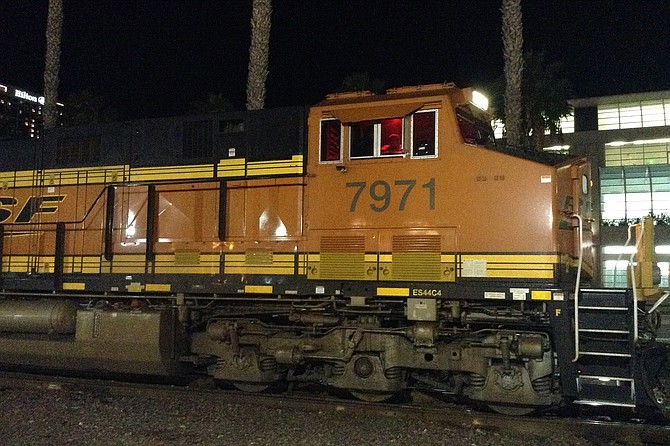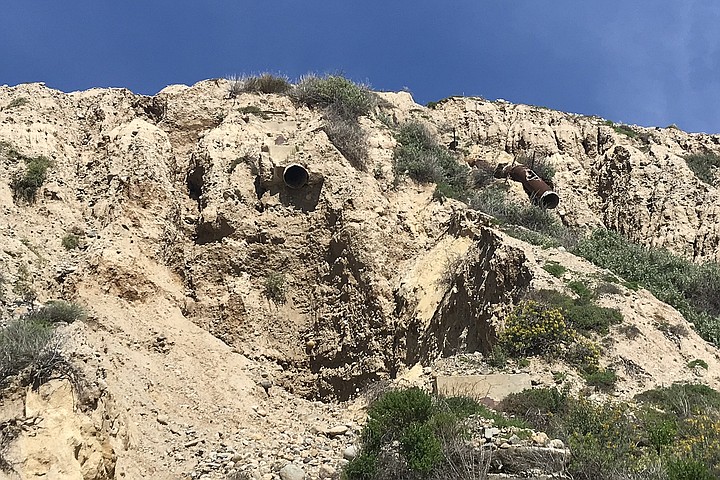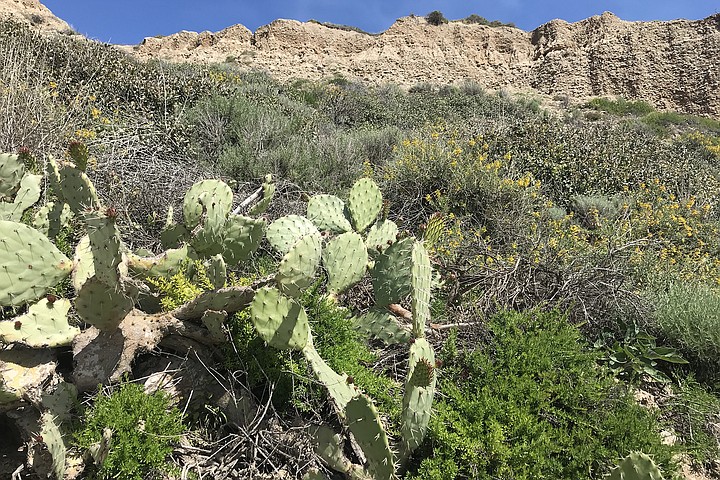 Facebook
Facebook
 X
X
 Instagram
Instagram
 TikTok
TikTok
 Youtube
Youtube

“How’s that cliff that fell away? I ask this train employee. I’m at the Santa Fe Depot, about to board the Coaster for Solana Beach. Feeling a touch queasy after reading about the piece of cliff in Encinitas that collapsed and crushed three beach walkers back on August 2nd. And then August 22nd, a 60-foot-wide chunk of a Del Mar cliff tumbled down, from right next to the rail line, the rail that we’re going to have to traverse in half an hour.
“They say it’s okay,” he says. “We have to slow down to less than 30 miles per hour so we don’t shake it up too much. And the freight trains, 10 miles per hour. I try not to look down.”

Man, that’s reassuring, because just using common sense, this is a crazy situation. The track we’ll be on was built in 1880. It was called the Surf Line. Nearly 140 years later, it’s still a single track that runs along a narrow ledge sometimes 40 vertical feet up from the Del Mar beach. The late November storm that dumped 2.5 inches of rain ate away at the cliff edge to within 20 inches of the railroad ties. The US Geological Survey says cliffs in Southern California could recede more than 130 feet by 2100, if sea levels rise as many predict.
Huge amounts of freight trundle up and down our only rail link out. Ten percent of all foreign cars sold in the U.S. land in San Diego, and travel by night train to LA.
Back on December 31st 1940, a freight train went over a bluff south of Del Mar after water seepage undermined the track and allowed the rails to spread. Three crew members were killed in that accident.
Today, many shorings-up later, the worries are that along with water seepage, the rumbling of the heavy goods trains is loosening the sandstone of the bluffs.
So why don’t we shift the tracks inland? Frank Stonebanks, who leads a group called “Citizens for Access to Del Mar Beach, Bluffs, and Trails,” is advocating exactly that.

“It’s going to take people waking up one morning and seeing ‘Pacific Surfliner crashes into the ocean. Fifty people dead,’” he told the Union-Tribune. “Unfortunately, until something like that happens, I don’t think anybody’s going to do anything about it.”
Indeed, the plan is to keep this 1.7-mile stretch of track along the Del Mar bluffs running for 30 more years before they move it inland. Part of the reason? A new, inland track could cost as much as $3.5 billion to engineer.
Now the train slows to what feels like walking pace. Orange-jacketed repair crews stand on shovels between the track and the cliffs. The gap between us and the vertical drop seems to shrink right up against the track ties. The wheels give a definite lurch. The carriage springs creak. I hold my breath. The train gradually starts picking up speed. Whew.
It’s not going to be easy to find the money and political backbone to move these tracks to safety inland. Especially with a well-oiled NIMBY machine in place. The question is, how big a chance are authorities taking with leaving this track as is, unchanged since 1880?
I get out at Solana Beach. “Good for another day,” says my friend, as he rolls gently north, door open. “Taking it one trip at a time.”


“How’s that cliff that fell away? I ask this train employee. I’m at the Santa Fe Depot, about to board the Coaster for Solana Beach. Feeling a touch queasy after reading about the piece of cliff in Encinitas that collapsed and crushed three beach walkers back on August 2nd. And then August 22nd, a 60-foot-wide chunk of a Del Mar cliff tumbled down, from right next to the rail line, the rail that we’re going to have to traverse in half an hour.
“They say it’s okay,” he says. “We have to slow down to less than 30 miles per hour so we don’t shake it up too much. And the freight trains, 10 miles per hour. I try not to look down.”

Man, that’s reassuring, because just using common sense, this is a crazy situation. The track we’ll be on was built in 1880. It was called the Surf Line. Nearly 140 years later, it’s still a single track that runs along a narrow ledge sometimes 40 vertical feet up from the Del Mar beach. The late November storm that dumped 2.5 inches of rain ate away at the cliff edge to within 20 inches of the railroad ties. The US Geological Survey says cliffs in Southern California could recede more than 130 feet by 2100, if sea levels rise as many predict.
Huge amounts of freight trundle up and down our only rail link out. Ten percent of all foreign cars sold in the U.S. land in San Diego, and travel by night train to LA.
Back on December 31st 1940, a freight train went over a bluff south of Del Mar after water seepage undermined the track and allowed the rails to spread. Three crew members were killed in that accident.
Today, many shorings-up later, the worries are that along with water seepage, the rumbling of the heavy goods trains is loosening the sandstone of the bluffs.
So why don’t we shift the tracks inland? Frank Stonebanks, who leads a group called “Citizens for Access to Del Mar Beach, Bluffs, and Trails,” is advocating exactly that.

“It’s going to take people waking up one morning and seeing ‘Pacific Surfliner crashes into the ocean. Fifty people dead,’” he told the Union-Tribune. “Unfortunately, until something like that happens, I don’t think anybody’s going to do anything about it.”
Indeed, the plan is to keep this 1.7-mile stretch of track along the Del Mar bluffs running for 30 more years before they move it inland. Part of the reason? A new, inland track could cost as much as $3.5 billion to engineer.
Now the train slows to what feels like walking pace. Orange-jacketed repair crews stand on shovels between the track and the cliffs. The gap between us and the vertical drop seems to shrink right up against the track ties. The wheels give a definite lurch. The carriage springs creak. I hold my breath. The train gradually starts picking up speed. Whew.
It’s not going to be easy to find the money and political backbone to move these tracks to safety inland. Especially with a well-oiled NIMBY machine in place. The question is, how big a chance are authorities taking with leaving this track as is, unchanged since 1880?
I get out at Solana Beach. “Good for another day,” says my friend, as he rolls gently north, door open. “Taking it one trip at a time.”
Comments